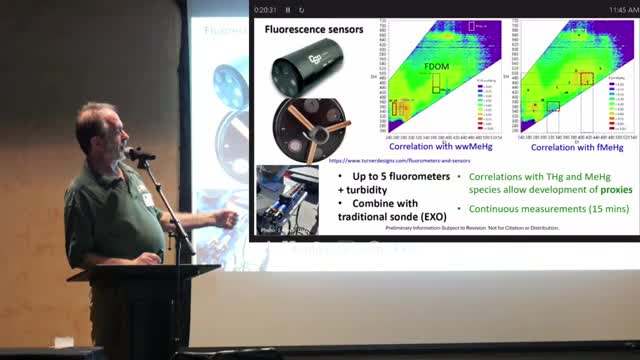Innovative technology revolutionizes mercury monitoring in water
August 16, 2024 | Events, Lake County, California
This article was created by AI summarizing key points discussed. AI makes mistakes, so for full details and context, please refer to the video of the full meeting. Please report any errors so we can fix them. Report an error »

In a recent government meeting, officials discussed advancements in environmental monitoring technologies, particularly focusing on the detection of emerging contaminants such as PFAS and methylmercury. The U.S. Geological Survey (USGS) highlighted the use of innovative fluorescence probes developed by Turner, which can be customized for various water bodies. This technology allows for frequent readings—every 15 minutes—offering a cost-effective alternative to traditional methylmercury analysis, which can run several hundred dollars per test.
The meeting also featured insights from Colin Eaglesmith, a prominent mercury scientist from Corvallis, Oregon, who has returned to work on projects at Clear Lake. Eaglesmith's team has made significant strides in biota sampling, collecting data on fish, zooplankton, and benthic invertebrates since the summer of 2020. Their comprehensive sampling efforts, illustrated through a detailed map, demonstrate a thorough approach to understanding the ecological impacts of mercury contamination in the lake.
These discussions underscore the importance of leveraging advanced technologies and scientific expertise to monitor and address environmental contaminants, ultimately aiming to enhance data collection and improve water quality management strategies.
The meeting also featured insights from Colin Eaglesmith, a prominent mercury scientist from Corvallis, Oregon, who has returned to work on projects at Clear Lake. Eaglesmith's team has made significant strides in biota sampling, collecting data on fish, zooplankton, and benthic invertebrates since the summer of 2020. Their comprehensive sampling efforts, illustrated through a detailed map, demonstrate a thorough approach to understanding the ecological impacts of mercury contamination in the lake.
These discussions underscore the importance of leveraging advanced technologies and scientific expertise to monitor and address environmental contaminants, ultimately aiming to enhance data collection and improve water quality management strategies.
View full meeting
This article is based on a recent meeting—watch the full video and explore the complete transcript for deeper insights into the discussion.
View full meeting
